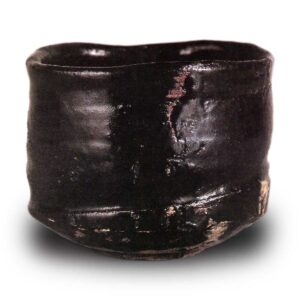
A type of Seto ware. It is also called Seto Kuro Oribe Kuro or Kuro Oribe, but they are all the same type. The name is derived from the iron hook or iron hash that was pulled out from inside the kiln during firing. The traces of these hooks or hashas are found on the vessels. Most of them are tea bowls, some of them are brownish brown when fired young, and those with a yuzu-skin glaze are considered to be the best.
Some have a plum-skin-like glaze surface, which gives them a different flavor. Some black-glazed vessels are white-glazed on half or part of the body and painted with iron sand, while others are white-glazed only and decorated with patterns. The black tea bowl of Yamaji is an example. There are two general types of tea bowl shapes.
One has a one-chimonji bottom and the other has a suribachi bottom, with the one-chimonji bottom being a cylindrical tea bowl with a low base. The one with a sliding bowl bottom is shallow and has a high base. The bowls with the above pattern are mostly in the latter type. Although the date of production is not known, the former can be dated to the Tensho and Bunroku periods (1573-96), and the latter to the Keicho period (1596-1615). According to “Hari no Hana,” “Oribe Kuro was invented by Chobei Kato (who later assumed the family name of Takashima), the 13th grandson of ceramic founder Keisho, and what is now commonly referred to as Hikide Kuro was also invented by Chobei.
However, this theory is incorrect. The black color is somewhat similar to Raku ware, but the clay is hard and the color of the clay is light blue. Some pieces are still light red in color. The color is very different from that of yaki-yaki, and it does not have an unpleasant luster, and it does not cool down for a long time even when filled with hot water. In general, the form and design are different from those of kuro-ragaku, and it is difficult to compare its interest with that of raku ware. It was produced around the same time as Raku ware, when the tea ceremony was at its peak in Japan, which explains the elegant design. The craftsmen must have met many tea masters and received their guidance, and after many years of practice, they were able to perfect their work. The beauty of this piece lies in its light elegance and simplicity, with the intention of being dense and the body rather sparse. The black drawer is placed outside of the saggars to make it easy to pull out, so it is easily covered with ashes and dust and sometimes discolored. The kiln marks called “Seto Roku-saku” or “Jusaku” are often found on these drawer black teacups. Many shards have been excavated from kiln sites in Mino such as Oyaya and Ohira-Kujiri.



